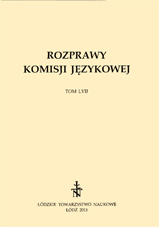Семиотика ритуала и ее отражение в славянских языках (на материале концепта «черта»)
Semiotics of ritual and its reflection in Slavonic languages (based on the concept “boundary”)
Author(s): Eugeniusz StefańskiSubject(s): Semiotics / Semiology
Published by: Łódzkie Towarzystwo Naukowe
Keywords: ritual; Slavonic languages; concept “boundary”
Summary/Abstract: The article analyzes the ancient ritual, which together with the myth is considered by the author as a semiotic system that preceded language. The author examines how in Slavonic linguistic cultures the concept “boundary”, based on the earliest spatial ideas, was formed. Later this concept under the influence of myth and ritual developed non-spatial semantics, which became a base for the formation of many moral concepts. This concept first had a sacred meaning as insurmountable barrier between own and alien, between nature and culture, ultimately between chaos and cosmos. In Indo-European languages the concept “boundary” verbalized as a root *měd- ‘middle’ (Lat. medius ‘middle’, Eng. middle, Rus. межа ‘boundary’, между ‘between’, Czech mez ‘boundary’, mezi ‘between’, Pol. miedza ‘boundary’, między ‘between’). It’s significant, that in Slavonic languages many words with this root and idioms with this preposition mean some unpleasant situation. The spatial concept boundary became very important for the formation many ethical and legal concepts. For example, in many Slavonic languages the term преступление ‘crime’ literally means “stepping over the law”. The author analyzes the actualization of the concept “boundary” in artistic discourse of two stories by Czech writer Milan Kundera.
Journal: Rozprawy Komisji Językowej
- Issue Year: 2011
- Issue No: 57
- Page Range: 233-244
- Page Count: 12
- Language: Russian

